Art - 2013
'09 maps for:
Bea
--
Buck -- Caley --
Claws --
Conomo --
Hix --
Hudson 09 -- Isabel --
Katy -- L.R. --
Moffet --
Mr. Hannah --
Ozzie --
Penelope
--
Rafael
2010 maps for: Belle
-- Buck --
Gunny --
Hudson --
Mr. Hannah --
Neale --
North Fork Bob
--
Penelope --
Sanford
-- Sr. Bones --
Thatch
2011 maps:
Belle --
Buck --
Henrietta --
Katbird
-- North Fork Bob --
Pemi --
Saco --
Sanford --
Sr. Bones --
Snowy --
Thatch -- Tucker
2012 maps: Art --
Belle --
Bridger --
Chip --
Cutch --
Jill -- North Fork Bob --
Rammie --
Snowy --
Sr. Bones -- Thatch
2013 maps: Art -- Belle --
Bridger -- DJ --
Donovan -- Edwin --
Icarius --
Mackenzie -- Nick --
North Fork Bob --
Quin -- Rammie --
Rodney -- Ron --
Snowy --
Sr. Bones -- Tango --
Woody
Osprey
main page --
Migration
page --
Migration09 --
Migration10 --
Migration 11 --
Migration 12 --
Migration 13 -- Home
Page
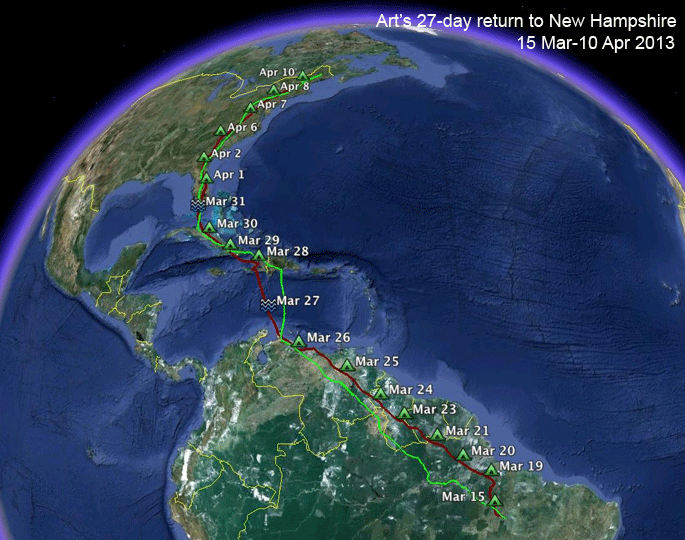 |
15 Mar-10 Apr 2013 -
Art took 27 days to get home from his wintering
waters down on the Rivers Tocantins and Araguaia
in eastern Brazil. The green track is his fall
route. He took 42 days to finish his fall
migration but only 27 to get home this spring.
The power of testosterone! Scroll down for more. |
|
15-20 Mar 2013 -
Art was one of three birds that started
migrating this spring within hours of each other
on the Ides of March. He spent five days closely following the Rio Tocantins and not moving very far each day. Finally, on the 20th, something kicked in and he made his first significant move towards home. While we're up here in our satellite, we can get a good feel for what's going on with deforestation in the Amazon. The enormous Kayapo Indian Reserve (which I've had the privilege of visiting) remains intact because about 7,000 native Americans live there. Just north of the reserve, one notices the "fishbone" pattern of deforestation that follows roads cut into the forest. |
|
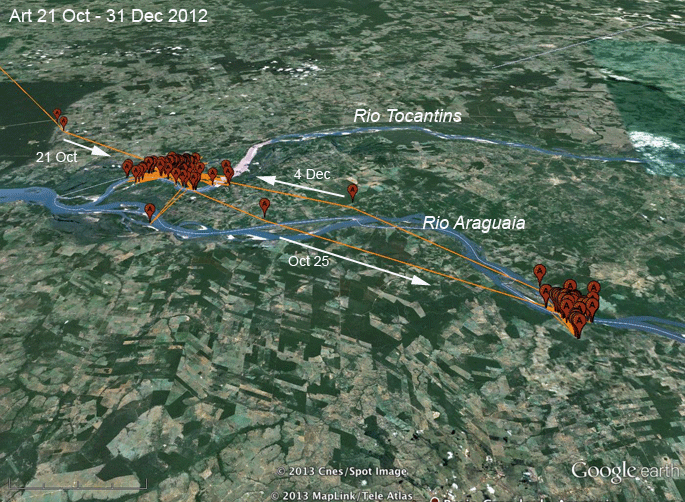 |
Winter 2012-13 (Oct-31 Dec 2012): After about a month and a half down on the Rio Araguaia, Art headed back to the Rio Tocantins. |
 |
1 Jan - 11 Mar 2013: Art has settled down on some ox-box lakes just north of the main channel of the Rio Tocantins. He should be heading north soon. |
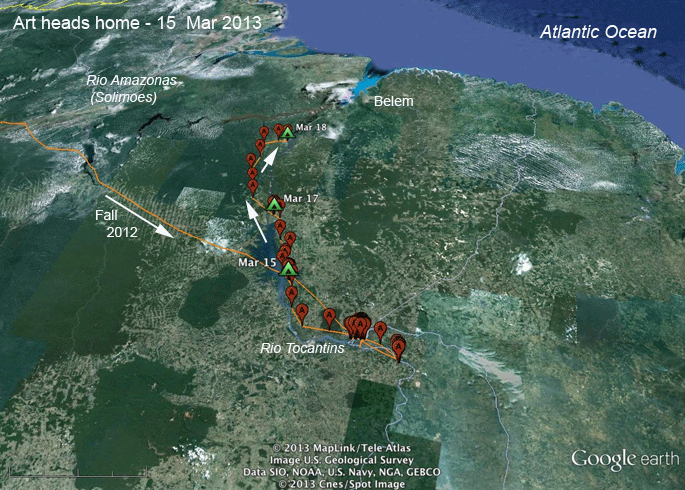 |
15-18 Mar 2013 -
Art was one of three birds that started
migrating this spring within hours of each other
on the Ides of March. He spent four days closely following the Rio Tocantins and not moving very far each day. After his first short trip on the 15th (he only flew for about 5 hours) he didn't move on the 16th. When he got going again on the 17th, he didn't really show us much in the way of migration mo-jo. He's still just poking along, and heading northeast towards Belem (that's Portugese for Bethlehem), when he really needs to get a move on and head northwest! |
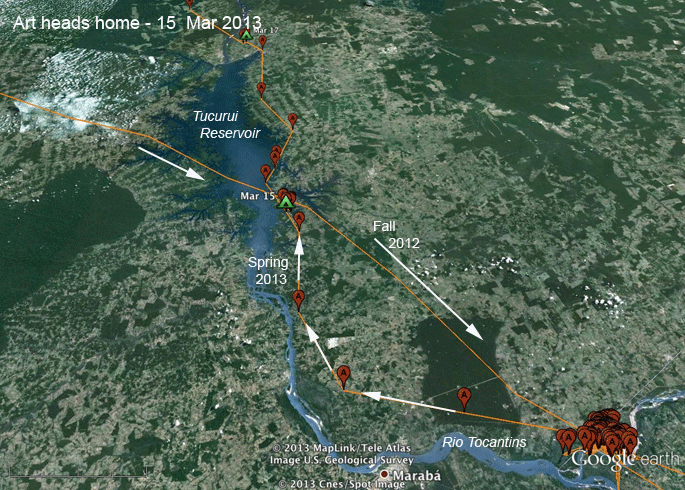 |
15 Mar 2013: And he's off! He normally gets
home around the first week in April, so he's got
to get a move on here. The first part of his migration was along the shores of the enormous Tucurui Hydroelectric Reservoir. |
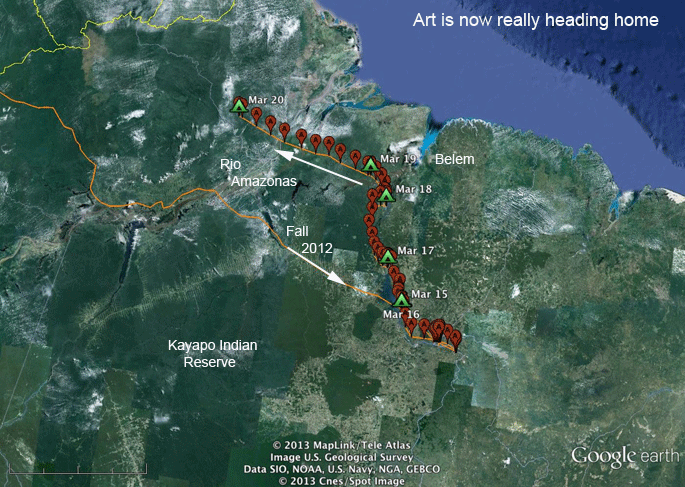 |
20 Mar 2013 - Art finally kicked on the afterburners and made some progress. He put in a full 9 hours of serious migration on the 20th. In the process he crossed the Rio Para, part of Marajo Island, which is part of the Amazon River delta, and the Amazon River itself. He finished the day 220 miles (350 km) closer to home. |
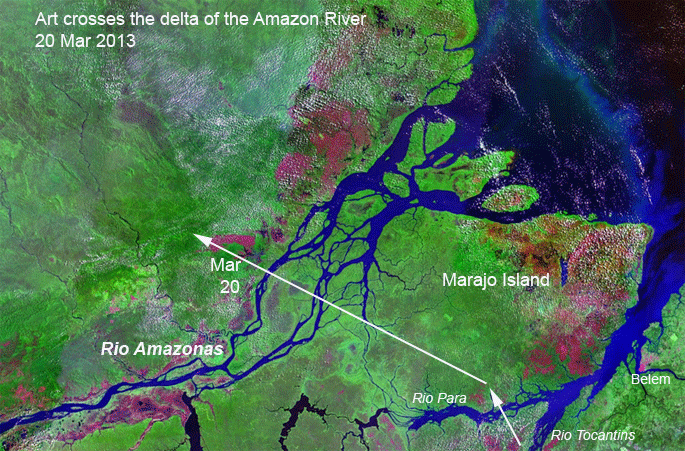 |
20 Mar 2013 -
Too many "teachable moments" as Art crosses the
delta of the Amazon with an uninspiring Google
Earth image to pass up. This is an older "false
color" satellite image, with Art's approximate
path indicated. Satellite images are a series of
data across many wavelengths that are
manipulated to look like what we'd see. Won't go
into the details, but the only thing here that's
about the right color is the forest. So, after Art got close to the mouth of the Tocantins, he headed northwest and crossed over Marajo Island, which at 15,500 square miles (40,000 km^2) is roughly the size of Switzerland and forms a big part of the Amazon delta. The main branch of the river passes north of the island. The Amazon drains an area roughly equal to the size of the lower 48 states. 20% of the world's moving fresh water passes through the delta. |
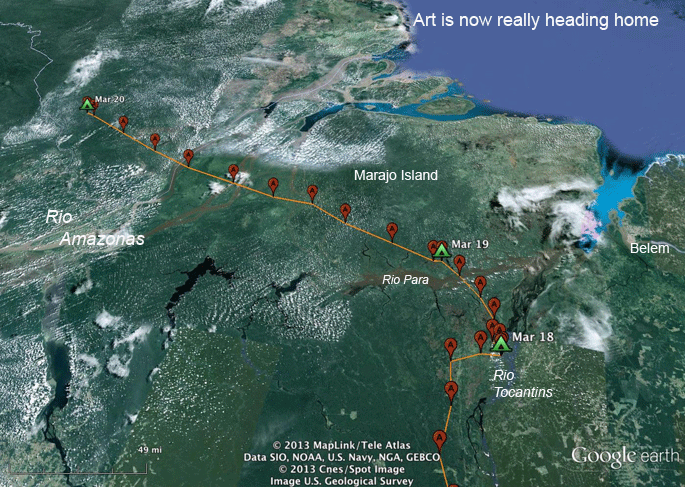 |
|